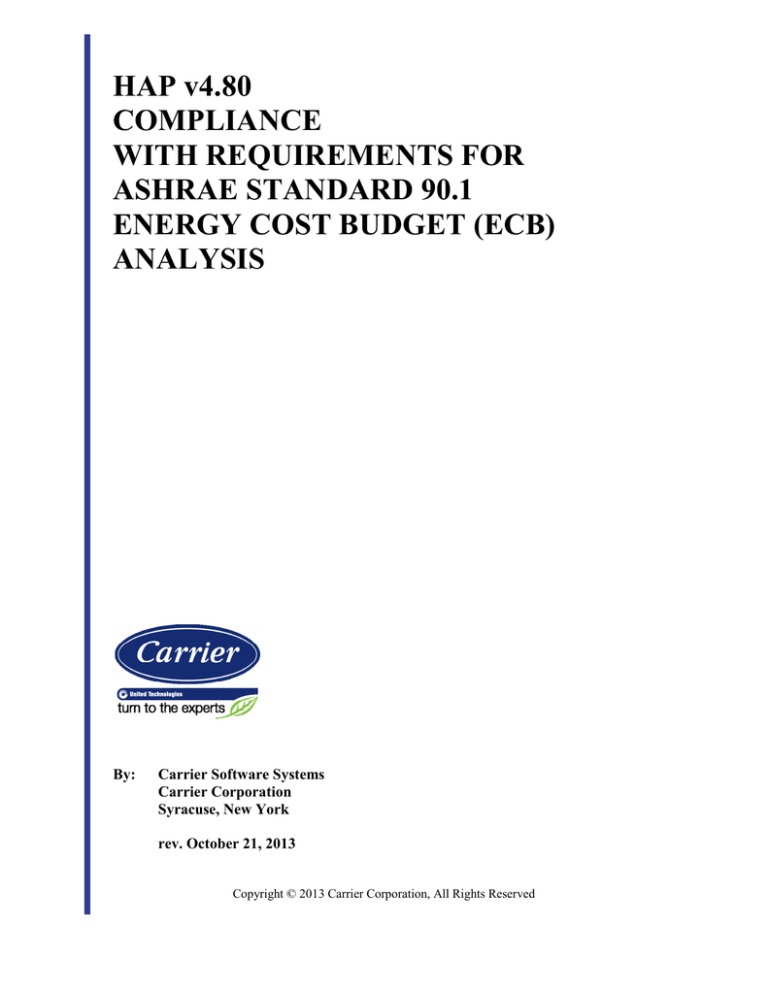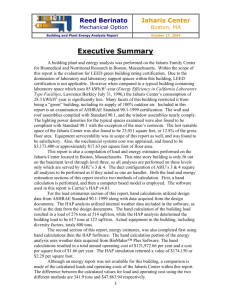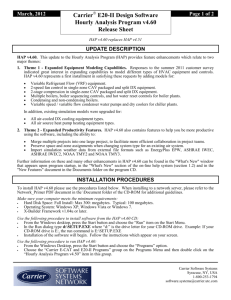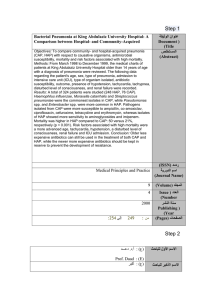
HAP v4.80
COMPLIANCE
WITH REQUIREMENTS FOR
ASHRAE STANDARD 90.1
ENERGY COST BUDGET (ECB)
ANALYSIS
By:
Carrier Software Systems
Carrier Corporation
Syracuse, New York
rev. October 21,, 2013
Copyright © 201
2013 Carrier Corporation, All Rights Reserved
Introduction
In ASHRAE Standard 90.1, the Energy Cost Budget (ECB) method is one of the paths that can be used to
demonstrate compliance with the Standard. This method requires use of an energy simulation tool to
calculate and compare energy costs for a “Budget Building Design” which incorporates prescriptive
requirements and the actual building design. This approach allows tradeoffs among many energy-related
components of the building. The Standard defines minimum requirements for software used in the ECB
analysis in Section 11.2. Carrier Hourly Analysis Program v4.80 compliance with these requirements is
documented in Table 1 below.
Table 1. Evaluation of HAP v4.80 Compliance with ASHRAE 90.1-2007 Section 11.2
ASHRAE Standard 90.1-2007, Section 11.2
Description of How HAP v4.80 Complies
11.2 Simulation General Requirements
11.2.1 Simulation Program. The simulation
program shall be a computer-based program for the
analysis of energy consumption in buildings (a
program such as, but not limited to, DOE-2 or
BLAST). The simulation program shall include
calculation methodologies for the building
components modeled.
Meets Requirements. HAP is a software program
intended for both the design of HVAC systems and
the analysis of building energy consumption.
HAP performs a true 8760-hour energy simulation
using TMY or TRY weather data and uses the
Transfer Function load calculation method.
The calculation methodologies used in HAP cover
most common building architectural features,
building materials, HVAC systems, and HVAC
equipment.
11.2.1.1 The simulation program shall be approved
by the adopting authority and shall, at a minimum,
have the ability to explicitly model all of the
following:
(a) a minimum of 1400 hours per year;
Exceeds Requirements. HAP calculates loads,
system and equipment performance for 8,760 hours
per year, making separate calculations for the
unique operating conditions in all 8,760 hours.
(b) hourly variations in occupancy, lighting
power, miscellaneous equipment power,
thermostat setpoints, and HVAC system
operation, defined separately for each day of
the week and holidays;
Meets Requirements. HAP permits all the listed
items to be scheduled on an hourly basis, with the
provision for defining separate schedules for each
day of the week and holidays.
(c) thermal mass effects;
Meets Requirements. HAP uses the Transfer
Function method to calculate loads, thereby
accounting for the storage and release of heat in the
thermal mass of the building.
(d) Ten or more thermal zones;
Exceeds Requirements. Up to 100 thermal zones
per air handling system and up to 25,000 unique
thermal zones per project are permitted.
(e) part-load performance curves for
mechanical equipment;
Meets Requirements. HAP provides part-load
performance curves and/or allows input of
performance curves for mechanical equipment.
(f) capacity and efficiency correction curves for
mechanical cooling and heating equipment.
Meets Requirements. HAP provides capacity and
efficiency correction curves for cooling and heating
equipment such as packaged DX units, split DX
units, air source heat pumps, water-source heat
pumps, chillers, and boilers.
HAP v4.80 Compliance with Requirements for ASHRAE Standard 90.1 ECB Analysis
Page 2
ASHRAE Standard 90.1-2007, Section 11.2
Description of How HAP v4.80 Complies
(g) air-side and water-side economizers with
integrated control; and
Meets Requirements. HAP provides models for
integrated air-side economizers and integrated
water-side economizers.
(h) the budget building design characteristics
specified in 11.2.5.
Meets
Requirements.
Budget
Building
requirements are not specified in section 11.2.5. If
this is meant to refer to section 11.3, HAP provides
capabilities to meet requirements in that section.
11.2.1.2 The simulation program shall have the
ability to either (1) directly determine the design
energy cost and energy cost budget or (2) produce
hourly reports of energy use and energy source
suitable for determining the design energy cost and
energy cost budget using a separate calculation
engine.
Meets Requirements. HAP is able to calculate
energy costs for the building itself and can also
provide hourly reports suitable for determining
energy costs separately.
11.2.1.3 The simulation program shall be capable
of performing design load calculations to determine
required HVAC equipment capacities and air and
water flow rates in accordance with 6.4.2 for both
the proposed design and budget building design.
Meets Requirements. HAP provides a full suite of
system design features. Load calculations are
performed using the ASHRAE Transfer Function
Method referenced in the ASHRAE Handbook of
Fundamentals. This complies with Section 6.4.2 of
the Standard which stipulates:
Heating and cooling system design loads for the
purpose of sizing systems and equipment shall be
determined in accordance with generally accepted
engineering standards and handbooks acceptable to
the adopting authority (for example, ASHRAE
Handbook-Fundamentals)
11.2.1.4 The simulation program shall be tested
according to ASHRAE Standard 140 and the results
shall be furnished by the software provider.
Meets Requirements. HAP v4.80 has been tested
according to ASHRAE Standard 140-2007,
Standard Method of Test for the Evaluation of
Building Energy Analysis Computer Programs.
Results are available on request.
11.2.2 Climatic Data. The simulation program
shall perform the simulation using hourly values of
climatic data, such as temperature and humidity
from representative climatic data, or the city in
which the proposed design is to be located. For
cities or urban regions with several climatic data
entries, and for locations where weather data are not
available, the designer shall select available weather
data that best represent the climate at the
construction site. Such selected weather data shall
be approved by the authority having jurisdiction.
Meets Requirements. HAP uses TMY and TRYtype hourly weather data for energy simulations.
11.2.3 Purchased Energy Rates. Annual energy
costs shall be determined using rates for purchased
energy, such as electricity, gas, oil, propane, steam
and chilled water, and approved the adopting
authority.
Meets Requirements. HAP permits input of
detailed information describing rate structures for
all of the energy and fuel sources listed.
HAP v4.80 Compliance with Requirements for ASHRAE Standard 90.1 ECB Analysis
Page 3
www.commercial.carrier.com
Carrier Corporation
Printed in USA




